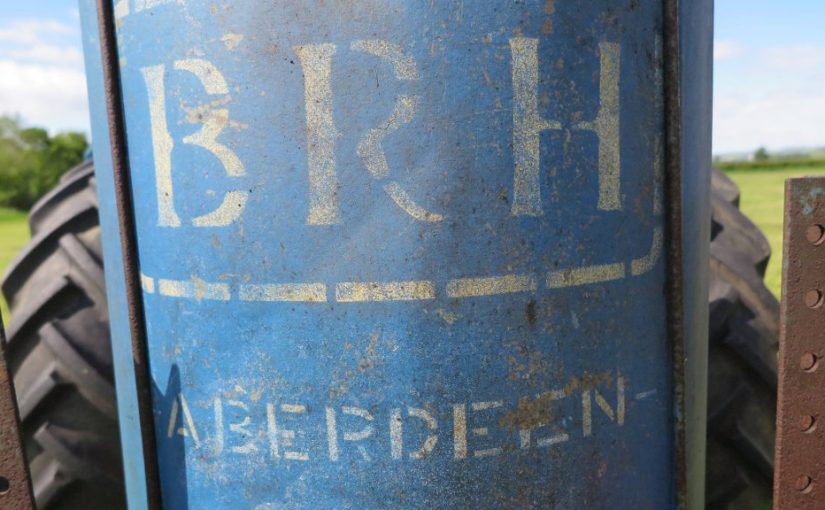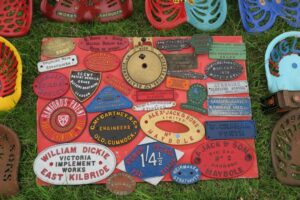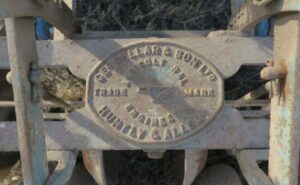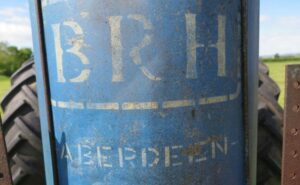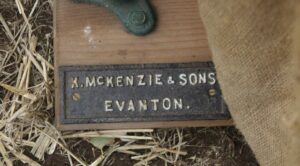The Highland Show was an important forum for the exhibition of the latest Scottish agricultural implements and machines. The Aberdeen show of 1931 was noted for the size of its implement yard but also for some of the important innovations that were on display. As the Aberdeen press and journal noted: “Engineering skill in the interests of the agricultural industry is strongly reflected”.
So what was on display at the Aberdeen highland of 1931? In sort, a wide range of the most up to date and innovative farm machinery made by the leading Scottish makers (as well as others from further afield). These included names well associated with the north-east and north of Scotland. The following account from the Aberdeen press and journal of 23 June 1931 sets out what one of its reporters thought of the show and what they found interesting:
“Implements for the farm – at the Highland Show
Manure distributor from Aberdeen
Many labour-saving devices
In the section set aside for implements and machinery there are 2,991 entries. This number creates a record for the Highland Show. The nearest approach to this total was at the Edinburgh show in 1927, when the collection was 2,874. At Aberdeen on the following year the number was 2,377.
The steward of this department is Mr J. P. Ross Taylor, Mungoswells, assisted by Mr charley tinker of Kilmartin, Inverness. There are over twenty new implements. The society is offering £1,000 of a prize doe the best new implement or machine. This offer remains open until the end of next year. The entries for this prize are to be submitted to practical trials not later than March of 1933, and must be submitted from the actual manufacturers or inventors.
Engineering skill in the interests of the agricultural industry is strongly reflected. At every turn one sees improved and labour-saving devices for the feeding of live stock, and new ideas in implements and machinery that reduce costs of outdoor and indoor farm work. Subjected to a long period of depression, farmers are keen on finding out how expenses can be reduced without efficiency being reduced in any way.
Northern stands
North country firms make a bold display, and are certain to attract attention from the thousands of visitors who wish to keep themselves abreast of the times. The stands include those of Aberdeen Journals, Ltd (“Aberdeen Press and Journal”); Aberdeen Town and County Association for Teaching the Blind at Their Homes.; W. Alexander, Ruthen, Watten, Caithness; Allan Brothers, Ashgrove Engineering Works, Aberdeen; Barclay, Ross, and Hutchison, Ltd, Aberdeen; Anglo-American Oil Coy ltd; J. P. Brown, Dipple, Fochabers.
Miss Davidson, Gushetneuck Pottery, Bieldside; James Ferries and Co., motor engineers, Inverness; Garvie, Innes, and Scott, Willowdale Place, Aberdeen; R. G. Garvie and Sons, Canal Road, Aberdeen; Macaulay Institute for Soil Research, Craigiebuckler, Aberdeen; Kenneth MacKenzie, engineer, Evanton, Ross-shire; Marshall and Philp, Aberdeen; John Milne and Sons, Montrose; North of Scotland College of Agriculture, Aberdeen.
Rowett Research Institute, Aberdeen; Scottish Home Industries Association, Nairn; George Sellar and Son, Ltd, Huntly; Sutherland Home Industries, Golspie.
Mr Kenneth MacKenzie, engineer, Evanton, who has a high reputation for the making of quality farm implements and machinery, has several of his own inventions at his no. 5 stand. They include a portable combined cleaner and cutter with engine; a practical and very desirable combination for sheep feeding; a turnip cutter with engine; sack holders and feeding barrows. Mr Mackenzie is the type of engineer that farmers and others should keep in touch with, because every now and again he is inventing something that plays an important part in the economic side of agriculture.
Foaling alarm
Farmers will be interested in stand 234, on which there is exhibited the “Brown-Souter” foaling alarm. Mr Brown, Dipple, Fochabers, is a director of the Society, and his co-inventor is Mr J. Stephen, Greyfriars Iron Works, Elgin.
This invention, particulars of which appeared in the “Press and Journal” some time ago, gives warning when a mare is about to foal.
It comprises a mechanical electrical device so designed that it is not possible for foaling to take place without a warning bell being rung. The bell may be fixed at any distance from the loose box or stable. The price is approximately £5.
From Caithness
Mr W. Alexander, Ruthen, Watten, Caithness, has an automatic trapnesting apparatus for recording the number of eggs laid by hens; the layer of an under-standard weight egg is also retained until released. When the eggs are collected, the egg belonging to any individual hen may be traced. This apparatus, with a turnip thinning machine, was made by Mr George Doull, Bellevue, Castletown, Caithness.
North country people, on approaching the Anglo-American Oil Company’s stand 331, are gripped by the striking and attractive display of the famous and popular Pratt’s High Test Petrol, and various kinds of oil and spirit. There are specimens of bulk storage installations, Valor heater and cookers, drums, cans, and Flit, the household insecticide.
J. L. and J. Ballach, Gorgie Implement Works, Edinburgh, have an improved revolving divider, for use with binders. The object of this divider is to make the operation of a binder cleaner and quicker.
Barclay, Ross and Hutchison, Ltd., Aberdeen, have, among other implements, the “SAI” manure distributor. Invented and made by the exhibitors, the machine is not an entirely new implement, but it is claimed that new principles are embodied in the design. The machine is also suited to sow all classes of fertilisers in any desired quantity from ½ cwt to 20 cwt per acre. The distributor is simple in construction, strong, and well-fitted.
The special feature is the mechanism adopted, whereby the machine is capable of sowing a very small quantity per acre with even distribution.
Other features are:-the size of the rollers and the way the shutting bar and scraper is applied, assure an accurate and even distribution. The adjustment with the single lever enables fertilisers to be sown at a minimum rate per acre. The speed of the distributing roller, and revolving stirrer arms inside the box, help materially in a regular and even distribution. The draught is extremely light. Gearing is simple and accurate. The standard size sowing width of the machine is 8 feet wide and 9 feet to centre of wheels. The distributor is easily cleaned by undoing a centre bush and removing the stirrer rod.”
